![]()
It’s been a potter’s field, an arsenal and a military parade ground. Until 1844, a major wagon route to Boston occupied its site. Madison Square opened to the public in 1847 and has, over the years, collected a variety of statues devoted to some of the lesser-known names in American history.

![]()
(1801-1872)
Location: southwest corner of Madison Square at 5th Avenue and 23rd Street
Sculptor: Randolph Rogers
Year installed: 1876
Senator William Henry Seward‘s main claim to fame is that he engineered the sale of Alaska from Russia to the U.S. in 1867. But he was also a powerful government figure: governor of New York, 1838-1843, U.S. Senator from New York, 1849-1861, and Abraham Lincoln and Andrew Johnson‘s Secretary of State, 1861-1869. At the 1860 Republican Convention he nearly beat out Lincoln for the nomination. Though antislavery, he opposed war with the Confederacy.
Seward was attacked by John Wilkes Booth the same evening that Booth assassinated Lincoln. (Booth’s brother, Edwin, is memorialized with a statue in Gramercy Park, a few blocks away.)
The statue, by Randolph Rogers, was unveiled in 1876. When Rogers completed a statue of Lincoln for Philadelphia’s Fairmount Park, there were striking similarities between the two figures, and some claimed that to save money he used the same figure twice. What happened is that the committee for the Seward statue was unable to afford the sculptor’s full fee. So with a few changes in body details, some repositioning of limbs, and the alteration of the Emancipation Proclamation to fit the size of the Alaska Purchase agreement, including the signature pen, Rogers was able to recycle the statue. Seward was the first New Yorker honored with a public monument.
This was the first heroic-size sculpture built in honor of a citizen of New York State.

![]()
(1828-1888)
Location: southeast corner of Madison Square at Madison Avenue and 23rd Street
Sculptor: John Quincy Adams Ward
Year installed: 1893
Described as a forceful, charismatic and flamboyant orator, Roscoe Conkling was a Senator of New York between 1867-1881 after two stints at the House. In 1876, Conkling lost in a squeaker to Rutherford B. Hayes for the Republican presidential nomination (Hayes later triumphed in the general election by amassing more electoral, though not more popular, votes than Democratic opponent Samuel Tilden, in a situation not unlike the 2000 presidential election.)
In March 1888 Conkling was caught outdoors near Union Square at the worst of the Blizzard of ’88 and died from exposure.
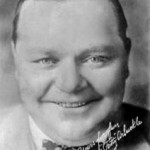 1920’s comedian Roscoe “Fatty” Arbuckle was named for the senator. Apparently, Arbuckle’s father thought his son was the product of an affair, so he named him after a hated politician of his youth…Senator Roscoe Conkling!
1920’s comedian Roscoe “Fatty” Arbuckle was named for the senator. Apparently, Arbuckle’s father thought his son was the product of an affair, so he named him after a hated politician of his youth…Senator Roscoe Conkling!
Conkling’s statue was supposed to go in Union Square, where he died, but city officials sniffed that he wasn’t important enough to appear alongside Washington, Lincoln and Lafayette there–so on to Madison Square he went.
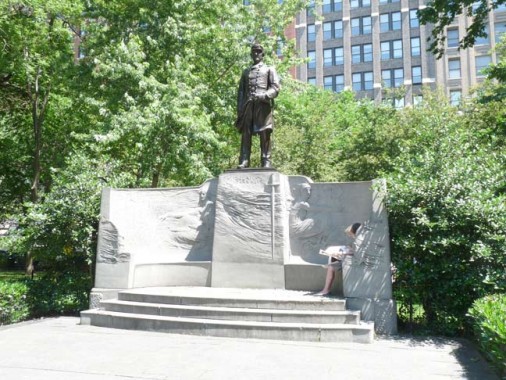
![]()
(1801-1870)
Location: midway between 5th and Madison, along the northern edge of the park along E. 26th Street
Sculptor: Auguste Saint-Gaudens
Year installed: 1881
 The greatest naval commander of the Civil War, David Farragut‘s father was a Spanish sea captain who fought for the colonies in the Revolution. After his mother died, his father allowed the boy to be adopted by U.S. naval officer; Farragut accompanied him during the War of 1812, and Farragut obtained his first command during the Mexican War in 1848.
The greatest naval commander of the Civil War, David Farragut‘s father was a Spanish sea captain who fought for the colonies in the Revolution. After his mother died, his father allowed the boy to be adopted by U.S. naval officer; Farragut accompanied him during the War of 1812, and Farragut obtained his first command during the Mexican War in 1848.
In 1862, when Farragut’s Union fleet took New Orleans, he was made a rear admiral. Fifteen months later, Farragut sailed to Mobile Bay to take on one of the Confederacy’s most indispensable ports.
At the height of the battle for Mobile Bay, Farragut was lashed to the mast of his ship so he could see further into the distance. Noticing that the bay was booby trapped with mines, Farragut chose to enter the bay anyway, shouting “Damn the torpedoes! Full speed ahead!” In the naval parlance of the day, a mine laid at sea was called a torpedo. The North took Mobile Bay.
Congress created the rank of vice admiral for Farragut, and he later became admiral. He died in 1870.
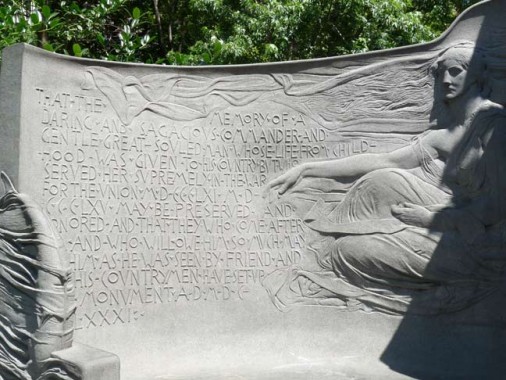
The Farragut Memorial was first located at 5th Avenue and 26th Street. In 1935 it was moved to its present location midway between Madison and 5th in front of East 26th.
Farragut is accompanied by two figures representing Loyalty and Courage, as well as by two dolphins. Sculptor Saint-Gaudens, who also created the statues of Peter Cooper at Cooper square and General Sherman at Grand Army Plaza, made extensive use of lettering, recounting Farragut’s career. The monument is regarded by experts as bringing revolutionary change to public sculpture–combining figure, pedestal, setting into a stylistic unity.
In 1881, the Farragut Monument was unveiled by a retired sailor…the same one who had tied Farragut to the mast during the Battle of Mobile Bay.
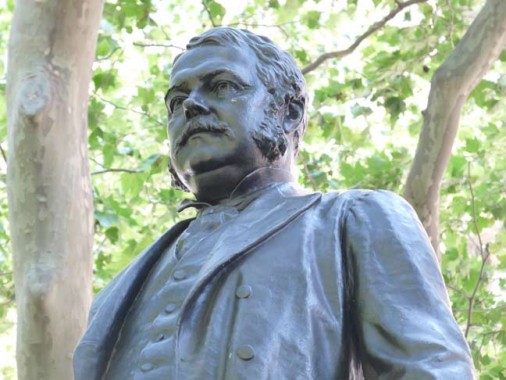
![]()
(1830-1886)
Location: just off the corner of Madison Avenue and East 26th Street on the park’s northern edge
Sculptor: George Edwin Bissell
Year installed: 1899
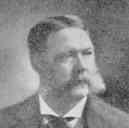 With his dignified bearing and carefully arranged whiskers, Chester Arthur looked the very model of a modern U.S. President (in the Victorian Age), which he was between 1881 and 1885. Born in Vermont but a transplanted New Yorker, he was elected as James Garfield’s vice-president and assumed office when Garfield was assassinated. He was a close friend of NY Republican senator Roscoe Conkling (see above).
With his dignified bearing and carefully arranged whiskers, Chester Arthur looked the very model of a modern U.S. President (in the Victorian Age), which he was between 1881 and 1885. Born in Vermont but a transplanted New Yorker, he was elected as James Garfield’s vice-president and assumed office when Garfield was assassinated. He was a close friend of NY Republican senator Roscoe Conkling (see above).
As President, he reformed civil service and introduced the merit system in federal employment. Despite Mark Twain’s support, he did not get the Republican nomination in the 1884 elections. However, it may have been just as well, because Arthur knew by then that he had a fatal kidney illness. He died in 1886.
During Arthur’s term, the Brooklyn Bridge opened in 1883.
Sculptor Bissell also created the statue of New Netherland governor Abraham DePeyster that is scheduled to return to Hanover Square.
![]()
Union Square is not named for any association with trade or labor unions, which were pretty much unknown when Union Square first opened in 1832. It takes its name from a confluence of two major roads, Broadway and the Bowery Road (which subsequently became 4th Avenue). Previously known as Union Place from 1808, it was built up and made a public park 24 years later. Nonetheless, Union Square became a popular gathering place for public speakers, some associated with the labor movement, some not.
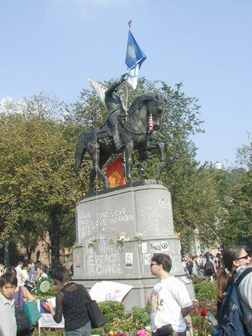
In the days following the destruction of the World Trade Center, Union and Washington Squares again became gathering places as loved ones and relatives of the missing came together to distribute pictures of the missing and create makeshift memorials.
The mounted statue of Washington in Union Square was the focal point of one such gathering in September 2001.
Union Square features statues of people who created and helped preserve nations…

![]()
(1869-1948)
Location: southwest corner of Union Square, traffic island at East 14th Street and Union Square West
Sculptor: Kantilal Patel
Year installed: 1986
 The inspirational spirit behind the founding of the modern Indian state in 1948 and leading advocate of the nonviolent protest movement, Mohandas K. Gandhi was born in Porbunder, India in 1869. The title Mahatma means ‘great soul’.
The inspirational spirit behind the founding of the modern Indian state in 1948 and leading advocate of the nonviolent protest movement, Mohandas K. Gandhi was born in Porbunder, India in 1869. The title Mahatma means ‘great soul’.
It’s a mistake to think that India gained its independence from Britain in a totally nonviolent way, but that the ascetic man with the walking stick wearing the dhoti’s principles were a guiding light can’t be denied.
Union Square was chosen as an appropriate location for Mohandas K. Gandhi’s statue due to its history as a center for nonviolent protest.
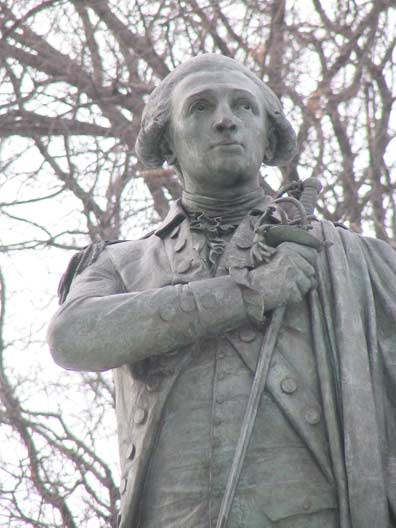
![]()
(1757-1834)
Location: east end of Union Square at Union Square East and East 15th Street
Sculptor: Frederic-Auguste Bartholdi
Year installed: 1876
It’s often forgotten how young Marie Joseph Paul Yves Roche Gilbert du Mothier, Marquis de Lafayette was when he came to America in 1777 to assist the colonists in the struggle for independence. He was just 19 years old when he arrived.
In commanding American and French troops during the Revolution, Lafayette was awarded an honorary generalship and remained a lifelong friend of Washington. Further uptown, the two are memorialized together in a statue alongside Morningside Park.
Upon returning to France, he was under arrest during the French Revolution and opposed the Napoleonic empire. He toured the rapidly growing United States in 1824. Along with Winston Churchill he is the only foreigner to be made an honorary U.S. citizen.
Ten years after Lafayette’s statue was dedicated in Union Square, a much larger statue by sculptor Bartholdi was dedicated: Liberty Enlightening The World.
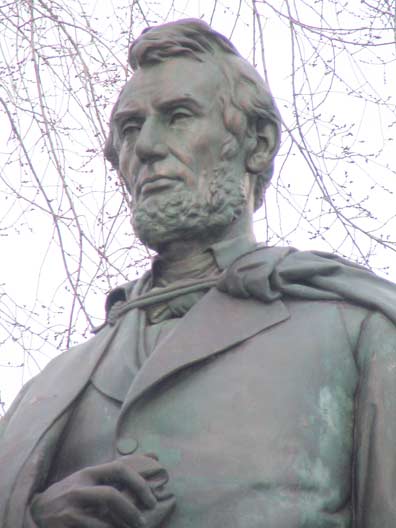
![]()
(1809-1865)
Location: north end of Union Square, at center of park in the line of East 16th Street
Sculptor: Henry Kirke Browne
Year installed: 1870
Lincoln had more to do with New York City than you might think. It was at Cooper Union, in February 1860, that he gave a speech on slavery that set many Republicans thinking he might be Presidential timber. Mathew Brady’s photography studio, where Lincoln sat for a famous portrait, was on Broadway in what we now call Soho. Nevertheless, the President-elect was given a tepid reception when visiting New York in 1861, as described by Walt Whitman. Lincoln never saw New York alive again. His funeral train passed through New York and his body lay in state at City Hall for a day.
Another Henry Kirke Browne portrait of Lincoln can be found in Brooklyn’s Prospect Park near the skating rink.
Another statue of Lincoln, by Charles Keck, is in a playground uptown at Madison Avenue and East 133rd Street.
Nearby in Gramercy Park is a statue of the brother of the man who assassinated Lincoln….

![]()
(1833-1893)
Location: Gramercy Park, visible from Irving Place and East 20th Street
Sculptor: Edmond Quinn
Year installed: 1918
Edwin Booth is the only actor to be memorialized with a bronze portrait in New York City.
Beginning in the mid- 1800s, Booth became renowned as a celebrated portrayer of Shakespearean roles, notably Hamlet (in which role he is shown in the statue). He was an innovator in a more natural acting style, as opposed to the harsher bombastic style that was popular then.
When Edwin Booth learned that his fanatically pro-Confederate actor brother, John Wilkes Booth, had murdered Lincoln, he went into temporary retirement. He later opened the Edwin Booth Theater on 6th Avenue and 23rd Street.
The Players Club, an acting society Booth founded, bestowed the portrait to Gramercy Park in 1918.
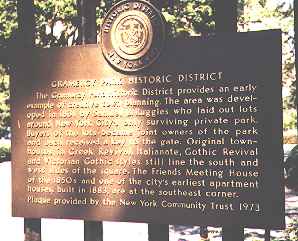
You’re not supposed to be here. And, neither am I. Gramercy Park is a one-block square private park between Park Avenue South and 3rd Avenue and East 20th and 21st Streets. Though to walk around it is to enter the NYC of 1880, walking IN it is verboten, unless you are lucky enough to reside along the exterior of the park. Only those residents have the keys to unlock the Gramercy Park fence.

![]()
(1592?-1672)
Location: Stuyvesant Square, west side of Second Avenue north of 15th Street
Sculptor: Gertrude Vanderbilt Whitney
Year installed: 1941
The severe Dutch colonial governor of New Amsterdam from 1653 to 1664 is remembered by two statues, one at Stuyvesant Square and another at St. Mark’s Church about six blocks downtown.
After the British sailed into New York harbor in 1664, Stuyvesant surrendered without firing a shot. He went to Holland to defend himself against charges of official misconduct, but later returned to his farm in Manhattan.
The Dutch word for farm is “bouwerie”; the main road that led to the farm is now The Bowery, while the short drive leading to the farm became Stuyvesant Street–one of the few diagonal NYC streets that were allowed to remain after the Commissioner’s Plan of a gridiron street layout was adopted in 1811.
A pear tree on Stuyvesant’s farm, planted in the 1600s, lasted until 1867–and only perished when two horsecarts ran into it. It was on the present-day corner of 3rd Avenue and 13th Street.
Stuyvesant Square, in which the statue stands, was sold to NYC for $5.00 by Peter Stuyvesant’s great-great-grandson. The four-acre parcel was once a part of Stuyvesant’s farm; Stuyvesant Street, a few blocks downtown, was once the road that led to his mansion.
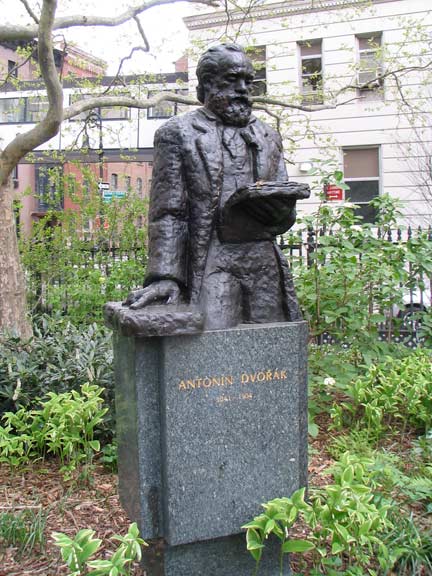
![]()
(1841-1904)
Location: Northeast part of Stuyvesant Square at East 17th Street and N.D. Perlman Place
Sculptor: Ivan Mestrovic
Year installed: 1997
Czech composer Anton Dvorák (pronounced, approximately, da-VOR-zhak) came to NYC in 1892 to direct the National Conservatory of Music. His most popular composition may be his ninth symphony, “Music From the New World.” While in NYC, he resided in a building at 327 East 17th Street, just across the street, now occupied by the Robert Mapplethorpe Residential Treatment Facility, named for the avant-garde photographer.

![]()
(1783-1859)
Location: Northwest corner of Irving Place and East 17th Street in front of Washington Irving High School
Sculptor: Friedrich Beer
Year installed: 1885 (Bryant Park; relocated in 1935 to its present location
Rip Van Winkle…Ichabod Crane…the Headless Horseman are all products of Washington Irving‘s imagination.
Unlike most streets which are named for luminaries after their death, Irving Place was so named in 1831, when Irving was at the height of his literary career.
In 1809, writing as Dietrich Knickerbocker, he wrote a playful history of New York. Humor would continue to serve Irving well throughout his career as a writer, diplomat and raconteur.
Washington made his home at his estate, Sunnyside, which still stands in Tarrytown. In the 1990s, nearby North Tarrytown voted to rename itself Sleepy Hollow after one of Irving’s fictitious locales.
SOURCES
All Around the Town: a Walking Guide to Outdoor Sculptures in New York City, Joseph Lederer, 1975 Scribners. OUT OF PRINT.
Guide to Manhattan’s Outdoor Sculpture. Margot Gayle & Michele Cohen, 1988 Prentice Hall Press. OUT OF PRINT but copies are available at some local bookstores.
12/11/2001

1 comment
That’s just weird